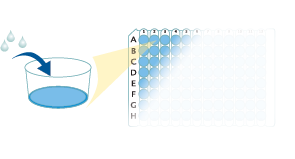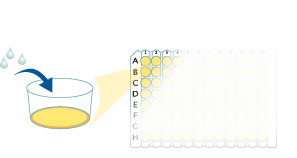Human SP-D Quantikine ELISA Kit Summary
Product Summary
Precision
Cell Culture Supernates
| Intra-Assay Precision | Inter-Assay Precision | |||||
|---|---|---|---|---|---|---|
| Sample | 1 | 2 | 3 | 1 | 2 | 3 |
| n | 20 | 20 | 20 | 40 | 40 | 40 |
| Mean (ng/mL) | 6.07 | 11.7 | 23.4 | 5.63 | 11.2 | 22.8 |
| Standard Deviation | 0.495 | 0.588 | 1.46 | 0.495 | 0.999 | 1.78 |
| CV% | 8.2 | 5 | 6.2 | 8.8 | 8.9 | 7.8 |
Serum, EDTA Plasma, Heparin Plasma
| Intra-Assay Precision | Inter-Assay Precision | |||||
|---|---|---|---|---|---|---|
| Sample | 1 | 2 | 3 | 1 | 2 | 3 |
| n | 20 | 20 | 20 | 40 | 40 | 40 |
| Mean (ng/mL) | 5.99 | 11.3 | 24.3 | 6.63 | 13.1 | 26.9 |
| Standard Deviation | 0.371 | 0.921 | 1.63 | 0.617 | 1.14 | 2.5 |
| CV% | 6.2 | 8.2 | 6.7 | 9.3 | 8.7 | 9.3 |
Recovery
The recovery of SP-D spiked to levels throughout the range of the assay in various matrices was evaluated.
| Sample Type | Average % Recovery | Range % |
|---|---|---|
| Cell Culture Media (n=4) | 102 | 95-109 |
| EDTA Plasma (n=4) | 110 | 99-120 |
| Heparin Plasma (n=4) | 104 | 85-118 |
| Serum (n=4) | 106 | 89-118 |
Linearity
Scientific Data
Product Datasheets
Preparation and Storage
Background: SP-D
Surfactant Protein D (SP-D) is a collectin family protein consisting of a collagen-like sequence followed by a C-type lectin domain. It is synthesized primarily in the lung by alveolar type II cells and unciliated bronchial epithelial cells. In addition, SP-D is produced by epithelial cells of the gastrointestinal tract and exocrine glands. SP-D binds to patterns of neutral sugars on micro-organisms to mediate direct opsonization and phagocytosis and is an important component of the innate immune system.
Assay Procedure
Refer to the product- Prepare all reagents, standard dilutions, and samples as directed in the product insert.
- Remove excess microplate strips from the plate frame, return them to the foil pouch containing the desiccant pack, and reseal.
- Add 100 µL of Assay Diluent to each well.
- Add 50 µL of Standard, control, or sample to each well. Cover with a plate sealer, and incubate at room temperature for 3 hours.
- Aspirate each well and wash, repeating the process 3 times for a total of 4 washes.
- Add 200 µL of Conjugate to each well. Cover with a new plate sealer, and incubate at room temperature for 2 hours.
- Aspirate and wash 4 times.
- Add 200 µL Substrate Solution to each well. Incubate at room temperature for 30 minutes. PROTECT FROM LIGHT.
- Add 50 µL of Stop Solution to each well. Read at 450 nm within 30 minutes. Set wavelength correction to 540 nm or 570 nm.





Citations for Human SP-D Quantikine ELISA Kit
R&D Systems personnel manually curate a database that contains references using R&D Systems products. The data collected includes not only links to publications in PubMed, but also provides information about sample types, species, and experimental conditions.
9
Citations: Showing 1 - 9
Filter your results:
Filter by:
-
Respiratory Effects of Traffic-Related Air Pollution: A Randomized, Crossover Analysis of Lung Function, Airway Metabolome, and Biomarkers of Airway Injury
Authors: Zhu, X;Zhang, Q;Du, X;Jiang, Y;Niu, Y;Wei, Y;Zhang, Y;Chillrud, SN;Liang, D;Li, H;Chen, R;Kan, H;Cai, J;
Environmental health perspectives
Species: Human
Sample Types: Serum
-
Treatment of Acute Respiratory Distress Syndrome Caused by COVID-19 with Human Umbilical Cord Mesenchymal Stem Cells
Authors: T Bukreieva, H Svitina, V Nikulina, A Vega, O Chybisov, I Shablii, A Ustymenko, P Nemtinov, G Lobyntseva, I Skrypkina, V Shablii
International Journal of Molecular Sciences, 2023-02-23;24(5):.
Species: Human
Sample Types: Plasma
-
Biomarkers of inflammation and epithelial barrier function in multiple sclerosis
Authors: A Olsson, S Gustavsen, IC Hasselbalc, AR Langkilde, F Sellebjerg, AB Oturai, HB Søndergaar
Mult Scler Relat Disord, 2020-09-19;46(0):102520.
Species: Human
Sample Types: Serum
-
Improving risk-stratification of rheumatoid arthritis patients for interstitial lung disease
Authors: J Avouac, A Cauvet, A Steelandt, Y Shirai, M Elhai, M Kuwana, O Distler, Y Allanore
PLoS ONE, 2020-05-08;15(5):e0232978.
Species: Human
Sample Types: Serum
-
Club cell protein 16 and cytokeratin fragment 21-1 as early predictors of pulmonary complications in polytraumatized patients with severe chest trauma
Authors: LL Negrin, G Halat, S Kettner, M Gregori, R Ristl, S Hajdu, T Heinz
PLoS ONE, 2017-04-05;12(4):e0175303.
Species: Human
Sample Types: Serum
-
Intraoperative cell salvage during cardiac surgery is associated with reduced postoperative lung injury.
Authors: Engels G, van Klarenbosch J, Gu Y, van Oeveren W, de Vries A
Interact Cardiovasc Thorac Surg, 2015-12-23;22(3):298-304.
Species: Human
Sample Types: Plasma
-
Circulating thymus and activation-regulated chemokine/CC chemokine ligand 17 is a strong candidate diagnostic marker for interstitial lung disease in patients with malignant tumors: a result from a pilot study.
Authors: Yamane H, Ochi N, Yamagishi T, Honda Y, Takeyama M, Takigawa N
Ther Clin Risk Manag, 2015-06-17;11(0):949-59.
Species: Human
Sample Types: Serum
-
Nintedanib modulates surfactant protein-D expression in A549 human lung epithelial cells via the c-Jun N-terminal kinase-activator protein-1 pathway.
Authors: Kamio K, Usuki J, Azuma A, Matsuda K, Ishii T, Inomata M, Hayashi H, Kokuho N, Fujita K, Saito Y, Miya T, Gemma A
Pulm Pharmacol Ther, 2015-04-02;32(0):29-36.
Species: Human
Sample Types: Cell Lysates
-
Expansive generation of functional airway epithelium from human embryonic stem cells.
Authors: McIntyre B, Alev C, Mechael R, Salci K, Lee J, Fiebig-Comyn A, Guezguez B, Wu Y, Sheng G, Bhatia M
Stem Cells Transl Med, 2013-12-03;3(1):7-17.
Species: Human
Sample Types: Cell Culture Supernates
FAQs
No product specific FAQs exist for this product, however you may
View all ELISA FAQsReviews for Human SP-D Quantikine ELISA Kit
Average Rating: 5 (Based on 1 Review)
Have you used Human SP-D Quantikine ELISA Kit?
Submit a review and receive an Amazon gift card.
$25/€18/£15/$25CAN/¥75 Yuan/¥2500 Yen for a review with an image
$10/€7/£6/$10 CAD/¥70 Yuan/¥1110 Yen for a review without an image
Filter by:
This assay passed our internal qualification with good dilutional linearity, accuracy, and precision.





